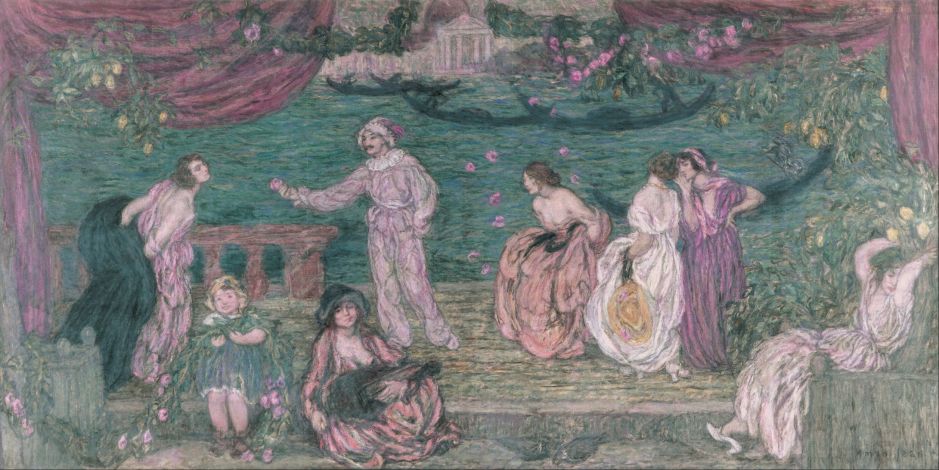By the late nineteenth century, the characters of the commedia dell’arte, including Pierrot, Harlequin and Pulcinella, had transferred from their original theatrical comedy to groups of travelling players performing Punch and Judy shows and similar, and had been adopted as clowns by circuses.

One of Émile Friant’s earliest works is this 1881 painting of The Entrance of the Clowns, showing the interior of the Big Top at the moment that the clowns, acrobats, and other entertainers parade. At the front is Pierrot, with Harlequin sprawling on the ground.

After James Tissot had returned to Paris later in his career, he included in his successful series of paintings about the modern woman, this view of Women of Sport (The Amateur Circus) from 1883-5. This derivative of the circus seems to have used notable members of the public as its performers, and features a clown in the ring below the trapeze artists.

Among Paul Cézanne’s figurative paintings is this of Mardi Gras (Pierrot and Harlequin) from 1888.

The smaller of Fernand Pelez’ two paintings of Grimaces et misères: les Saltimbanques (Grimaces and Miseries: the Acrobats) follows the pattern of a traditional ‘ages of man’ image, where its figures increase in stature from the start at the left edge, to the centre, then diminish again with advancing years, to the right. Standing in the middle are Pierrot and Harlequin.
Les Saltimbanques had been a successful show in the theatre fifty years earlier, and had lived on in entertainments staged in fairs around France. Rosenblum summarises this painting as presenting “a glum view of the contrast between the goals of rousing entertainment in a popular Parisian circus troupe and the actual melancholy and isolation of the performers.” That sounds about right for Pierrot, at least.

Pelez’ later La Vachalcade (The Cow-valcade) (1896) is a reversal of a portrait of an affluent family by way of parody. Thirteen young revellers are taking part in a carnival procession, perhaps one of the Vachalcades which took place in Montmartre at the time. Some wear masks, others have the close-shorn hair characteristic of the poor, a measure against endemic parasites.
At the centre is a boy very similar to The Little Lemon Vendor, wearing an adult’s jacket and a huge hat. Behind him is a Pierrot character, and in the background a banner bearing the word Misère – misery. Dangling on that is a dead rat, a reference to a well-known café on the Place Pigalle. The ‘vache’ (cow) in the title refers to the French phrase manger de la vache enragée, meaning to live in poverty.

Pierre-Auguste Renoir painted this full-figure portrait of his son Jean as The White Pierrot during 1901-02.

As Watteau earlier, Walter Sickert became interested in traditional pantomime, seen in this gouache of Pierrot and Woman Embracing from about 1901. This is a preliminary sketch for a painting now in a private collection, Venetian Stage Scene.

Sickert spent much of the summer of 1915 visiting Brighton, where he made studies for Brighton Pierrots. This is a commissioned copy of his original, which remains in a private collection, and like that was painted following his return to his London studio. It shows a small group of entertainers who performed daily on a temporary stage set up on the beach.

Although William S Horton was born in Grand Rapids, Michigan, and trained in Chicago, Paris, and New York, he painted almost entirely in Europe. In about 1917, he arrived in Britain, and in 1920 painted this Punch and Judy show taking place on the beach at Broadstairs, Kent, a traditional family beach resort at the extreme eastern tip of the south-east coast of England.
The lead male character of a Punch and Judy show, Mr Punch, is based on Pulcinella, a trickster figure who batters his wife, Judy. The first recorded show in Britain was on 9 May 1662, using marionette puppets. For the last two hundred years or so, a stylised version performed using glove or other puppets has been popular with children visiting British resorts, and later beach resorts. In 1827, George Cruikshank made a series of sketches of a performance, which were turned into the first illustrated and printed script.

Edmond Aman-Jean’s Festival of Venice from 1923 is set at an open-air performance involving a Harlequin character with a moustache, who is offering a woman a pink flower, presumably in an effort to woo her. At the right is a chorus of three women, and another sits in a chair at the far right asleep. A young woman seated at the front of the wooden stage is playing a hurdy gurdy, and a girl to the left of her is making a floral decoration.
The descendants of the commedia dell’arte live on, five centuries after the first Pierrots and Harlequins brought laughter to audiences. And they live on in paintings too.

